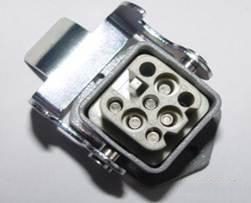Common faults of cold-pressed heavy-duty connectors:
1. Poor contact

Methods of troubleshooting:
1. The effective contact distance, mating surface, and the height of each pin should be basically the same. When the connector is inserted, the distance from the insertion force to the insertion position is obviously increased, which is generally more than 2mm; at the same time, check whether the height of each pin on the mating surface is basically the same to eliminate the defect caused by the individual pin The effective contact distance of individual pins is insufficient.
2. Whether the female needle has holding power. Eliminate by testing the holding force one by one.
3. Whether the core body is firmly assembled. It is ruled out by checking whether the insert body will go back as a whole.
4. The pin is withdrawn. It is ruled out by checking whether the height of each pin on the mating surface is still basically the same after the connector is inserted.

Common faults of cold-pressed heavy-duty connectors: 2. Retract the needle when inserted
Methods of troubleshooting:
1. Poor crimping leads to improper assembly. At the crimping place, the crimping is too deformed or bent, which causes interference with the corresponding mounting hole and cannot be assembled in place.
2. Due to component defects, lead to poor pin guidance. Generally, the pin squeeze traces of the male pin are left at the mating end of the female pin.
3. Defects in parts lead to unreliable support. The support is unreliable due to the defects of the parts, such as the support platform of the insert or the defect of the shrapnel on the pin.
4. The assembly is not in place due to other reasons. The assembly is not in place due to reasons such as too thin wires or too small holes.
















 RCCN WeChat QrCode
RCCN WeChat QrCode Mobile WebSite
Mobile WebSite